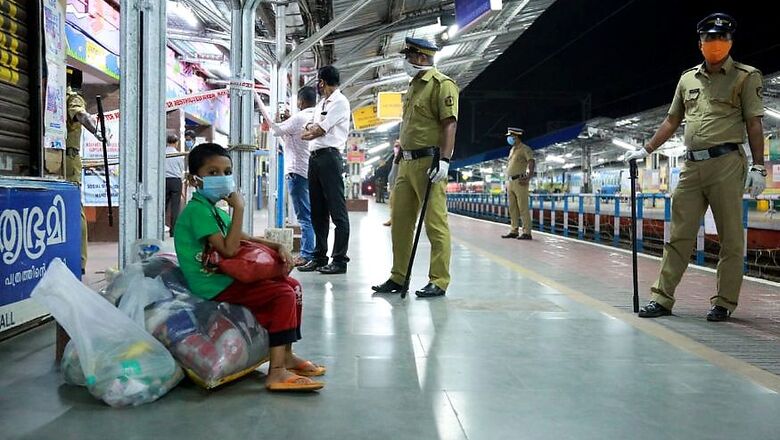
views
Bihar Legislative Assembly election's probable deciding factor is currently making his way back home after a 40-day-battle with hunger, joblessness, deplorable living conditions and a forced separation from family — all in the midst of a global pandemic. As migrant workers finally return, Chief Minister Nitish Kumar has a steep and time-bound task ahead of erasing memories of the long-drawn struggle by the time polls arrive in the next six months.
The term of the present Bihar Assembly ends on November 29.
Over 10 lakh workers from all over the country are expected to make their way back home. While this may seem a small fraction when compared to more than seven crore voters in the state, the cascading effect of their electoral choice may end up influencing close to six per cent votes.
News18 reached out to labourers from Bihar who are still stuck in various states. All of them expressed their displeasure with the state government.
"Our pleas to return home were continuously rejected. We have been surviving on one meal a day. Ration shops were charging extra. There has been no work ever since the lockdown was imposed. We had hoped to return on April 14 when the first phase of lockdown ended but that didn't happen. How can the state leave us stranded for over a month? Do they want us to die?" said Chintu Kumar, 28, a resident of Madhubani district in Bihar. Construction worker by profession, he along with six others have been stuck in a 10 by 10 feet room in Haryana's Gurugram.
India imposed a nationwide lockdown on March 24 aimed at curbing the spread of coronavirus, leaving crores of migrant labourers stranded.
Similarly, Raju Singh, 37, had to go without food for two days till state help arrived. "How could the government completely forget us?" he said. Singh was also not able to get in touch with his family back in Sitamarhi for days after mass quarantine was implemented.
An indication of the sentiment among migrant workers towards CM Kumar may also be drawn from a video that surfaced on April 15. "We want to convey this to you that talk to PM Modi and arrange special buses to ferry us to Bihar...Open your ears and listen to us carefully...otherwise, the ground beneath your feet will sink away..." said a group of workers from Bihar in a video posted on social media. They were stranded at Badarpur border in Delhi.
Till last week, 84 lakh ration card holders in the state were given Rs 1,000 each taking the financial assistance to a whopping Rs 840 crore. The government plans to regularise another 38 lakh suspended ration cards and pay three months pension to 87 lakh pensioners.
However, Nitish Kumar has been facing flak from the opposition over evacuation of students from Kota and alleged inept handling of the pandemic leading to an unprecedented swell in the number of positive cases from 69 to nearly 500 in three weeks.
News18 earlier reported how the ferry-back of migrants will put to test Bihar's social and economic infrastructure.
Can opposition take advantage?
Rashtriya Janata Dal (RJD) leader and former deputy chief minister Tejashwi Yadav mounted an attack on the state government for ‘abysmally low testing’, draining of medical supplies and alleged apathy towards the migrant labourers and students from Bihar stranded in other states.
Yadav accused the government of not having a concrete plan to fight the menace, nearly two months after the outbreak of the coronavirus.
RJD has also offered to make its state headquarters a quarantine centre or an isolation ward. Yadav has sent a cheque of Rs 1.25 crore for the CM Relief Fund and asked his MLAs to provide all possible help.
However, experts feel that the opposition has not been able to capitalise the situation.
"RJD has not been able to take political advantage. The NDA government would have taken a serious hit if the opposition was strong. They have not been able to create a connect with the public. Just social media posts and criticism of the government is not enough," said political analyst Sanjay Kumar.
"Even if not financially, they could have done a lot more in providing emotional support," he added.
Moreover, the Grand Alliance stands divided over its chief ministerial candidate. The combination of RJD, Congress, Rashtriya Lok Samata Party led by Upendra Kushwaha, Hindustani Awam Morcha led by Jitan Ram Manjhi and Vikassheel Insaan Party headed by Mukesh Sahani are yet to unanimously agree on one name that can be pitched to lead the government if they win.
Will caste vote sway?
It is common knowledge that elections in India cannot be won devoid of caste, more so in Bihar. OBCs form the largest voter base for both, Janata Dal (United) (JD(U)) and RJD. According to estimates, this caste group constitutes 50 per cent of the state's population. Nitish Kumar enjoys greater popularity among non-Yadav OBCs, mostly part of the sub-caste: Extremely Backward Caste (EBC).
A February 2020 study by Institute of Population Sciences concluded that more than half of the households in Bihar are exposed to migration to more developed places in India and abroad. Added to this, the 64th National Sample Survey stated that 22 per cent of the migrants are from OBC households and 19.3 per cent belong to scheduled castes and scheduled tribes. This includes skilled migrants.
Experts suggested that almost the entire unskilled migrant workforce from Bihar belongs to Backward Castes (BCs) and Extremely Backward Castes (EBCs).
This caste group has been seen to align with the JD(U) in the recent past. EBCs, Mandal communities minus the dominant trio of Yadavs, Kurmis and some Bania groups, are 22 per cent of Bihar's population. They voted almost unanimously for CM Kumar in 2015 Assembly elections and have been doing so ever since 2005.
However, if JD(U) fails to provide for the migrants, experts opine that it may result in a major shift across sub-castes.
"Almost 7-8 per cent of the votes may go against Nitish Kumar. People have suffered a lot. They had a lot of expectations from their chief minister. If they don't find jobs and enough to eat and if the pandemic spreads further it will seriously dent JD(U)'s chances. The situation is so grim and unprecedented that it may for the first time result in EBCs voting against their favourite leader," said political analyst and specialist in Bihar, Naveen Upadhyay.
Will women stand by Nitish?
Women in the past have voted as an undivided block for Nitish Kumar. So much so that they were credited for his victory in 2015 Assembly elections.
To woo this silent constituency, he has introduced a bouquet of schemes: cycles for girls to go to school, increased representation for women in panchayats and municipal elections, from 33 per cent to 50 per cent; a promise to reserve 35 per cent of all state government jobs for women, in addition to the 35 per cent reserved for them in the police.
However, this year women have been part of the misery. While ratio of female migrants is low, most of them have had to bear the brunt of their husbands and brothers not being able to return home.
"My elder brother is in Madhya Pradesh ever since the lockdown. He used to send close to Rs 5,000 every month. My father works as an agricultural labour and earns only during the seasons. He has not been able to send money. We hope he returns home as soon as possible but the financial struggle will be huge this year," said Lata Rani, a resident of Gaya district.
Moreover, the return of masses of migrant workers has catapulted thousands of female community health workers to the frontline of coronavirus care in rural Bihar, working without any protective gear.
ASHA workers have been directed to visit homes for screening and tutor households about the benefits of social distancing. Most of them have complained of not receiving masks, gloves and hand sanitizers. The National Commission for Women on April 15 wrote a letter to Bihar Chief Secretary Deepak Kumar asking the state to equip these frontline workers.
There are close to a lakh ASHAs in the state.
Can Sushasan Babu repeat Kosi Flood success story?
The veteran politician and three-time chief minister is no stranger to handling a calamity.
When Kosi floods devastated most parts of North Bihar in 2008, it was the Nitish Kumar government that had come to the rescue winning hearts of lakhs of migrants. The then Manmohan Singh government had declared it a national calamity 12 years ago.
On August 18, 2008, an embankment at Kusaha in Nepal had breached, leaving the entire Kosi belt in Bihar submerged. The floods had killed more than 500 people and rendered more than 30 lakh people homeless.
Many attribute the landslide victory of the Nitish-led NDA in the Lok Sabha and assembly polls in 2009 and 2010 respectively to the state government’s efficient management of the post-deluge situation.
However, the state government came under serious criticism last year when 130 children died last due to acute encephalitis syndrome, something the NDA government has not been to handle.
This time it is a virus.




















Comments
0 comment